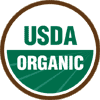 Organic food is produced by farmers who emphasize the use of renewable resources and the conservation of soil and water to enhance environmental quality for future generations. Organic meat, poultry, eggs, and dairy products come from animals that are given no antibiotics or growth hormones. Organic food is produced without using most conventional pesticides; fertilizers made with synthetic ingredients or sewage sludge; bioengineering; or ionizing radiation. Before a product can be labeled "organic," a Government-approved certifier inspects the farm where the food is grown to make sure the farmer is following all the rules necessary to meet USDA organic standards. Companies that handle or process organic food before it gets to your local supermarket or restaurant must be certified, too.
Organic food is produced by farmers who emphasize the use of renewable resources and the conservation of soil and water to enhance environmental quality for future generations. Organic meat, poultry, eggs, and dairy products come from animals that are given no antibiotics or growth hormones. Organic food is produced without using most conventional pesticides; fertilizers made with synthetic ingredients or sewage sludge; bioengineering; or ionizing radiation. Before a product can be labeled "organic," a Government-approved certifier inspects the farm where the food is grown to make sure the farmer is following all the rules necessary to meet USDA organic standards. Companies that handle or process organic food before it gets to your local supermarket or restaurant must be certified, too.
The NOP regulations prohibit the use of genetic engineering, ionizing radiation, and sewage sludge in organic production and handling. As a general rule, all natural (non-synthetic) substances are allowed in organic production and all synthetic substances are prohibited. The National List of Allowed Synthetic and Prohibited Non-Synthetic Substances, a section in the regulations, contains the specific exceptions to the rule.
Production and handling standards address organic crop production, wild crop harvesting, organic livestock management, and processing and handling of organic agricultural products.
Organic crops are raised without using most conventional pesticides, petroleum-based fertilizers, or sewage sludge-based fertilizers. Animals raised on an organic operation must be fed organic feed and given access to the outdoors. They are given no antibiotics or growth hormones.
Labeling standards are based on the percentage of organic ingredients in a product.
Products labeled "100 percent organic" must contain only organically produced ingredients. Products labeled "organic" must consist of at least 95 percent organically produced ingredients. Products meeting the requirements for "100 percent organic" and "organic" may display the USDA Organic seal.
Processed products that contain at least 70 percent organic ingredients can use the phrase "made with organic ingredients" and list up to three of the organic ingredients or food groups on the principal display panel. For example, soup made with at least 70 percent organic ingredients and only organic vegetables may be labeled either "made with organic peas, potatoes, and carrots," or "made with organic vegetables." The USDA seal cannot be used anywhere on the package.
Processed products that contain less than 70 percent organic ingredients cannot use the term “organic” other than to identify the specific ingredients that are organically produced in the ingredients statement.
More information available from The National Organic Program.
